Spaghetti with seafood is a traditional seafood dish with an irresistibly tasty sauce.
For my seafood sauce, I used:
• shellfish and crustaceans [clams, prawns, and squid];
• clam broth;
• a broth made from prawn heads.
It’s a white seafood sauce, and the broth from prawn heads and just a couple of tablespoons of tomato sauce make it even more flavorful, adding a slight hint of color.
Our favorite pasta shapes are:
• whole wheat square spaghetti;
• spaghetti No. 5;
• thick spaghetti.
It can’t be considered a quick recipe: cleaning and preparing the various types of seafood takes time, but the final result is worth every effort.
Spaghetti with seafood represents a single dish as it combines the characteristics that distinguish a balanced meal in one serving.
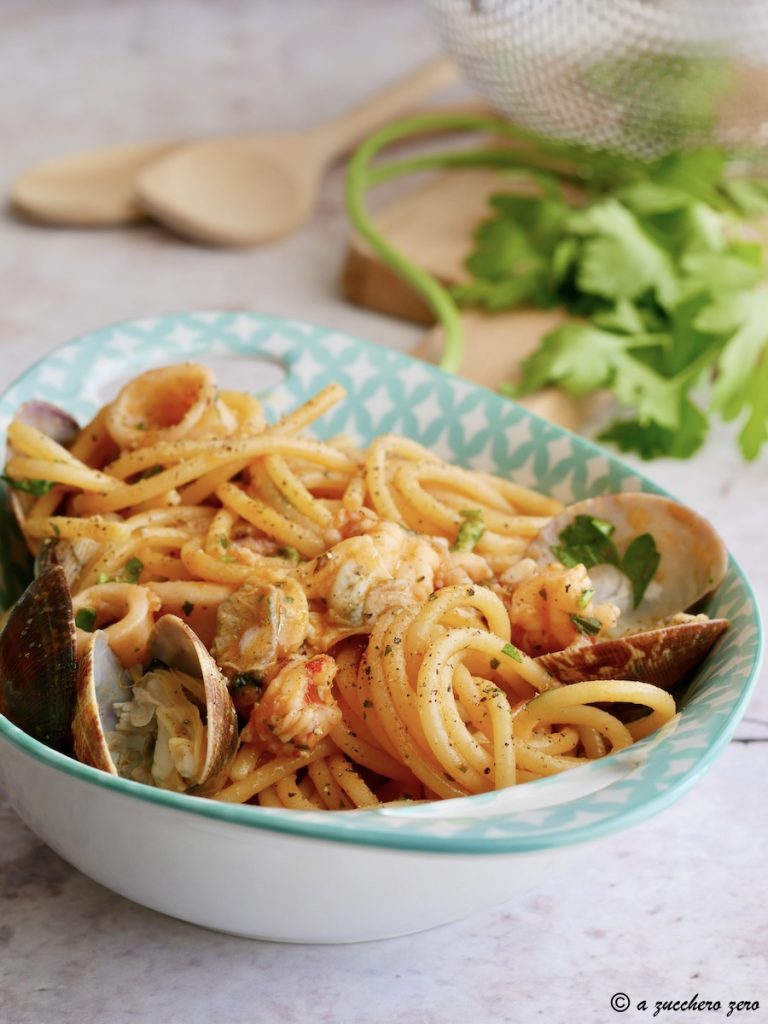
- Difficulty: Medium
- Cost: Medium
- Rest time: 2 Hours
- Preparation time: 40 Minutes
- Portions: 2 People
- Cooking methods: Stove
- Cuisine: Italian
Ingredients
- 5.6 oz spaghetti no. 5
- 1.1 lbs clams
- water
- salt
- 1 pinch garlic powder
- dried red chilies (a couple whole)
- 4 parsley stems
- 1 shot glass white wine
- 1 pinch mixed peppercorns (with grinder)
- to taste chopped parsley
- 8 prawns (at least 4 per person)
- 2 squid (at least 1 per person)
- prawn heads (at least 4)
- 1 shot glass white wine
- 1 ladle water
- 1 pinch salt
- 1 pinch mixed peppercorns (with grinder)
- to taste tomato sauce (homemade)
- 1 vegetable stock cube (homemade)
- to taste chopped parsley
- 1 drizzle extra virgin olive oil (raw)
Tools
- 1 Pan with lid preferably glass
- 1 Saucepan small
Preparation
My kitchen allies for cleaning clams:
• bowl and colander for purging clams from sand;
• fabric strainer to filter clam broth.
As an alternative to the fabric strainer:
1 Strainer with fine mesh
1 Paper Towel 2-ply
2 BowlsClean the clams
Pour the clams into the sink.
Remove clams with broken shells and empty shells.
Slam each clam vigorously on a cutting board and discard those that release sand.
Wash the clams under running water to remove any remaining impurities.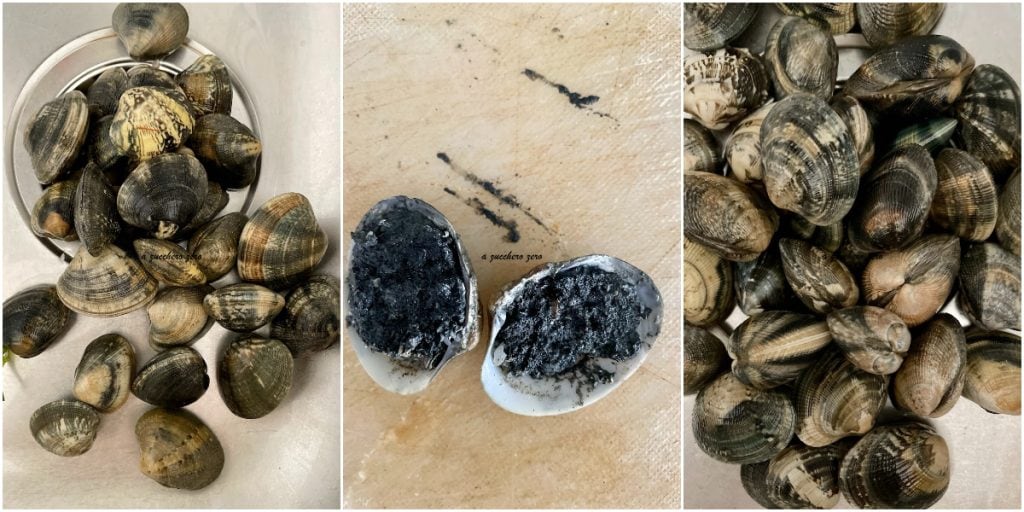
Purge the clams from sand
Transfer the cleaned clams to a colander.
Fill a large bowl halfway with water, add salt, and stir with a spoon.
Place the colander with clams in the bowl with water and salt, and add more water until a few inches from the edge.
I used a 3.5-liter bowl and colander and added two tablespoons of fine salt to the water.How long do clams need to purge?
Clams need to purge for at least 2 hours.Clean the clams
Remove the colander with clams from the bowl.
Slam each clam again vigorously on a cutting board and discard those that release sand.
Rinse the clams under running water to remove any remaining impurities.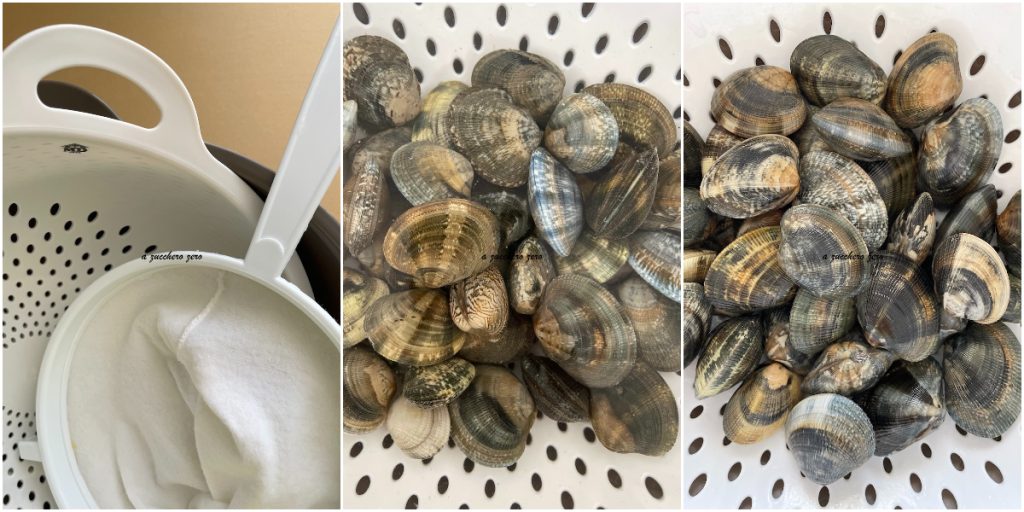
Open clams in the pan
In a pan or pot, heat a sprinkle of garlic powder, a couple of whole dried red chilies, and some parsley stems to flavor.
Add the clams to the pan and stir quickly.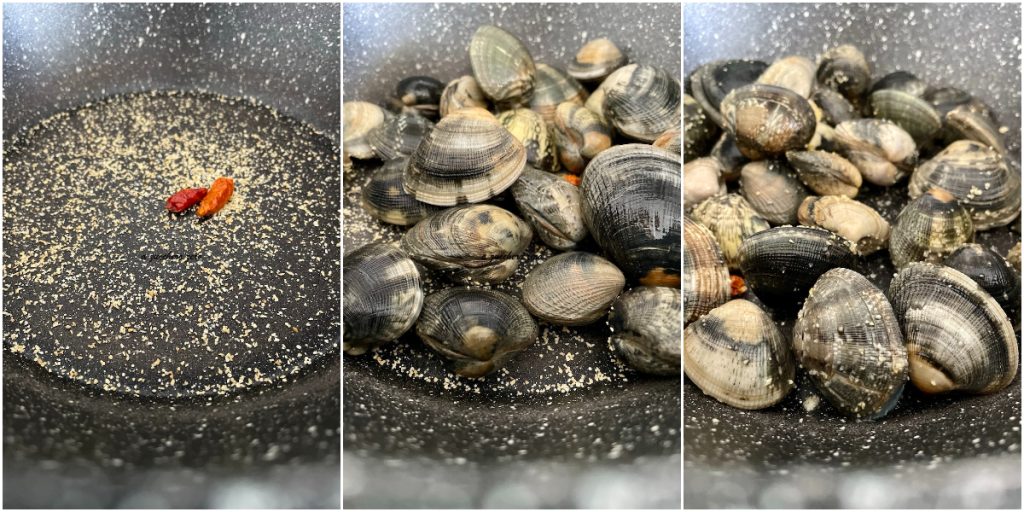
Deglaze with a shot glass of white wine.
Cover with a lid [preferably glass] and cook on high heat for 2-3 minutes, shaking the pan occasionally, until the clams have fully opened.
Let the clams rest in the pan with the lid on for a few minutes so that the heat trapped inside opens any stragglers.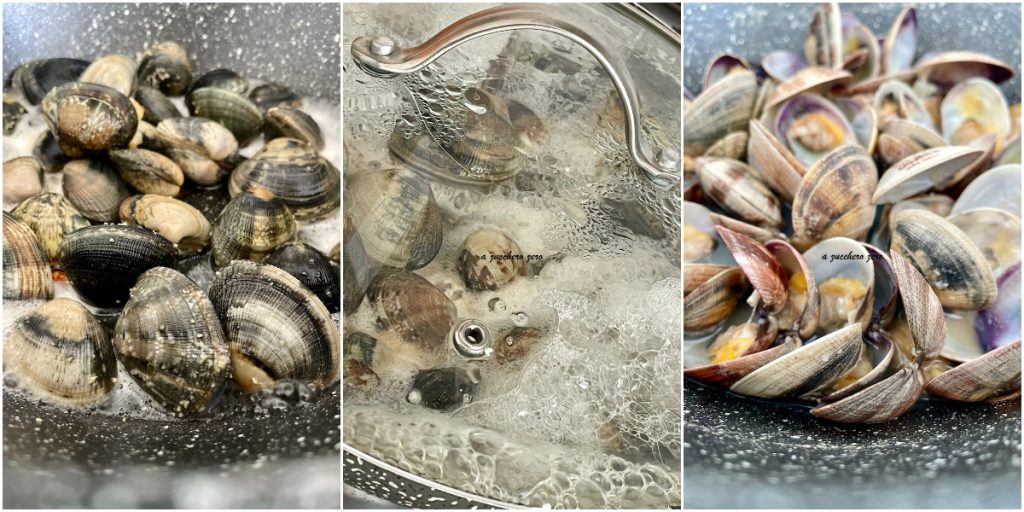
Filter the clam broth
Remove the clams from their liquid and transfer them to a deep dish.
Only if the clams are visibly sandy or have other impurities [this unfortunately depends on the product], consider rinsing them quickly under running water to not compromise the final preparation that we will flavor with the filtered broth.
Season the clams with pepper and parsley and cover them with another deep dish to keep them moist.
Use a fabric strainer or line the inside of a fine-mesh strainer with a 2-ply paper towel.
Place the strainer over a bowl and pour the clam liquid through it to filter.
Apart from any impurities, the garlic powder, chilies, and parsley stems will also be retained.
Clam broth and veracious clams are ready.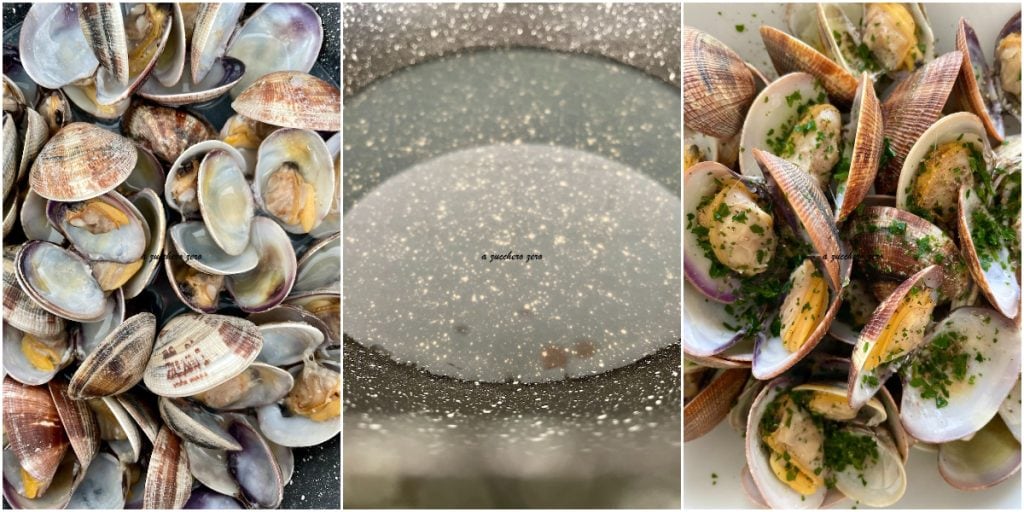
I chose prawns over shrimp, simply for convenience: peeling and cleaning 8 prawns is undoubtedly easier than peeling and cleaning 2 portions of shrimp.
Clean the prawns following the instructions in how to clean prawns:
Gently separate the heads from the bodies.
Set aside the heads for the broth preparation.CLEAN THE PRAWNS
Shell the prawns.
Then remove the black vein, which is the intestine, whose content is not toxic but can ruin our dish:
• make an incision on the back of the bodies with a sharp knife;
• extract the black vein or intestine with the help of a toothpick.
Wash the prawns thoroughly under running water and let them drain in a colander.
Pat dry any residual water with kitchen paper towels.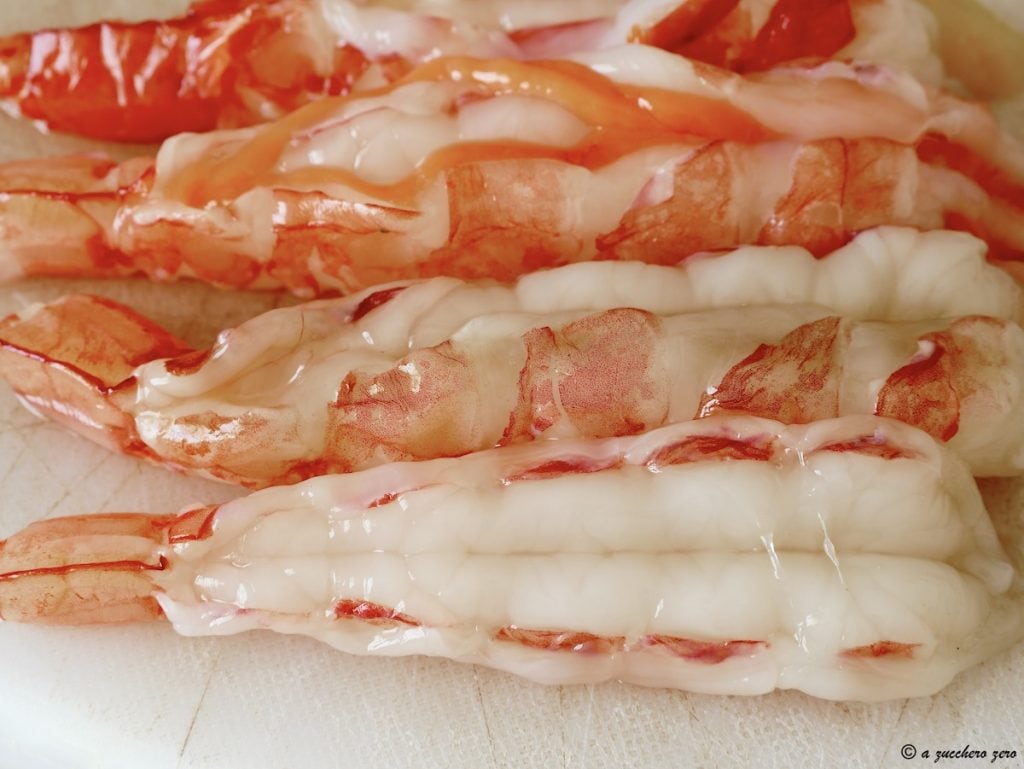
Cut the cleaned and shelled prawns into chunks.
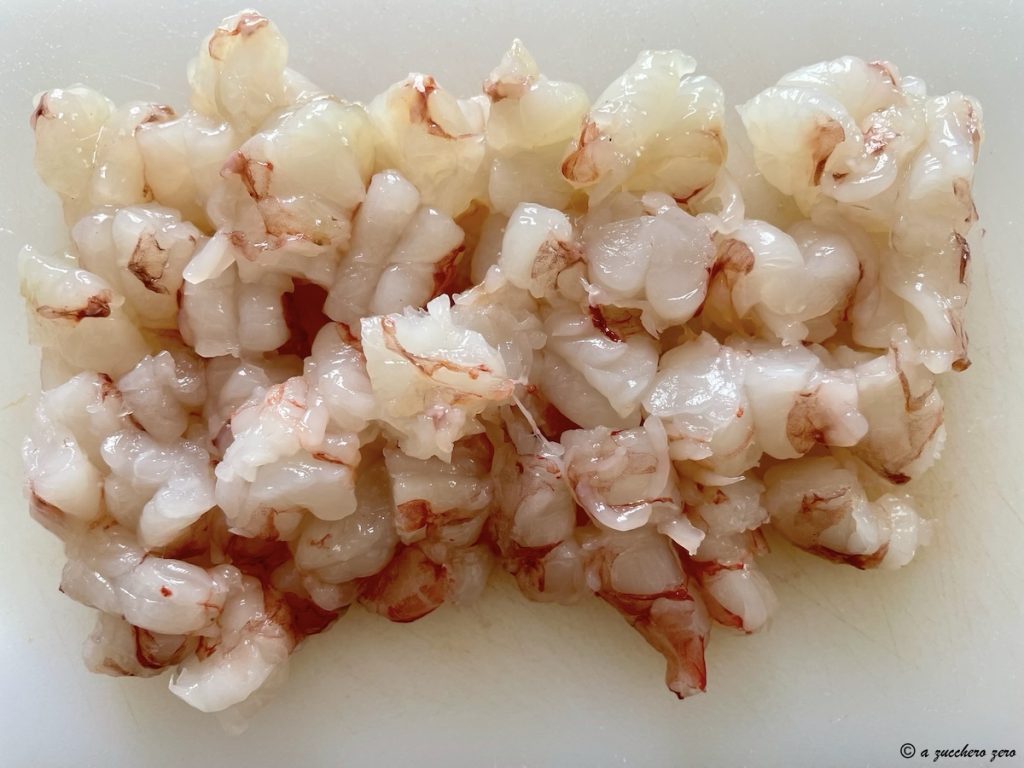
Wash the prawn heads set aside for the broth thoroughly under running water, as if rinsing a small container, until removing the internal organs, then let them drain in a colander.
Cleaning squid
Buy squid from your trusted fishmonger, asking for them to be cleaned.
If not, proceed with cleaning the squid:
• pull the head with tentacles out of the bag along with the ink sac if the squid has one;
• remove the cartilage from the mantle;
• remove the guts from the bag;
• continue cleaning the bag by pulling the skin;
• rinse the bag well under water [both outside and inside];
• continue cleaning the tentacles by removing the eyes and extracting the beak;
• rinse the tentacles well under water.
With this process, you will get closed bags to cut into rings.
Cut the bags into rings, separate the tentacles, and leave them whole or cut into chunks according to taste and needs.
Let them drain in a colander and pat any residual water with kitchen paper towels.In a hot small saucepan, add the prawn heads and brown them on both sides.
Deglaze with a shot glass of white wine.
Moisten with a ladle of water.
Let it simmer with a lid on low heat for 3-4 minutes.
Let cool or chill.
Using kitchen tongs, remove the prawn heads from the saucepan, allowing the retained broth to escape.Bring the prawn head broth to a boil.
Add the squid and continue cooking for 5 minutes.
Add the prawns and continue cooking for 3-4 minutes.
Add:
• a pinch of salt;
• a pinch of pepper;
• a couple of tablespoons of tomato sauce;
• a vegetable stock cube;
• parsley;
and mix.RETURN TO OUR PAN OR POT WITH THE FILTERED CLAM LIQUID.
Cook the pasta a couple of minutes less than the time indicated on the package.
Meanwhile, heat:
• the clam broth [in the pan or pot];
• the sauce with squid and prawns [in the small saucepan];
until bringing them to a boil.
Rinse the pasta under running water and drain.
Pour the pasta into the pan with the clam broth.
Complete the remaining minutes of pasta cooking by repeatedly stirring with a silicone spatula, as if it were a risotto, finishing with the addition of the sauce with squid and prawns and lastly the clams.
Mix.Plate.
Drizzle with a bit of raw oil, grind some more pepper, and add some more parsley.Your seafood spaghetti is ready.
Enjoy your meal!
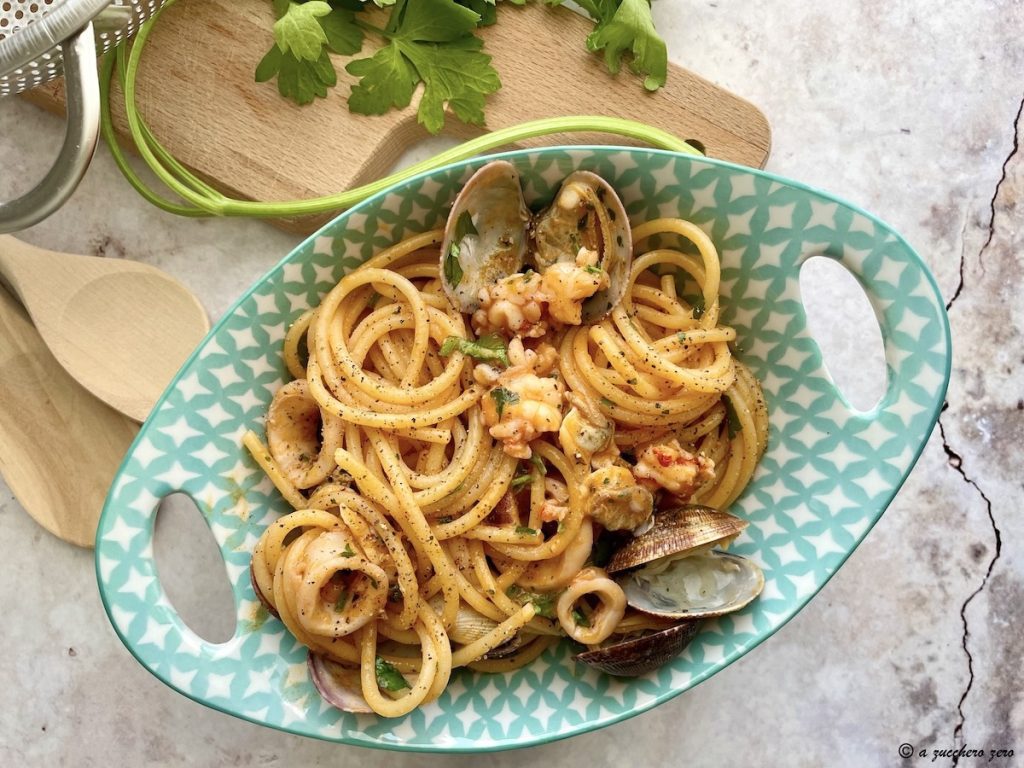
Prawns
Briefly, it’s important to remember that they are crustaceans low in triglycerides but high in cholesterol and also contain a small portion of available carbohydrates, which is why they are not suggested and included in all diets.
This applies to all types of prawns [from large prawns to small shrimps].
In my husband’s dietary plan, prawns are present and classified as foods to be consumed occasionally.Squid
In our dietary plan, squid and cuttlefish are among the foods indicated with two asterisks, i.e., ** to be consumed occasionally.
Indeed, although they are mollusks with lean meat, they are a source of cholesterol, whose intake should be limited.
Notes
Hyperglycemia, prediabetes, and diabetes.
Here you can find dedicated recipes.
Remember:
• start the meal with a generous portion of vegetables [raw or cooked];
• a balanced meal must contain all nutrients: carbohydrates, proteins, fats, & fibers;
• always prepare it respecting the proportions and combinations indicated in your dietary plan.
***
DO NOT COPY AND PASTE MATERIAL FROM THE BLOG in general and especially ON SOCIAL PROFILES AND GROUPS [photos, ingredients, procedure – NOT EVEN AS A SUMMARY]: it is correct to share your photos of the executed recipes indicating the source, i.e., linking the blog where the full recipe can be read.
FOR COPYRIGHT REASONS AND ALSO FOR THE LOT OF WORK BEHIND IT.
Thank you.

